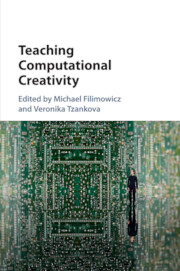Book contents
- Teaching Computational Creativity
- Teaching Computational Creativity
- Copyright page
- Contents
- Figures
- Tables
- Notes on Contributors
- Acknowledgments
- Introduction: Pedagogies at the Intersection of Disciplines
- PART I NEW FOUNDATIONS
- PART II CODE AS MEDIUM
- PART III PHYSICAL{LY} COMPUTING
- PART IV ONLINE LEARNING
- PART V CRITICAL PEDAGOGY
- PART VI TRANSDISCIPLINARY
- Interviews
- Afterword: Toward a Curricular Synthesis
- Index
- References
PART I - NEW FOUNDATIONS
Published online by Cambridge University Press: 04 July 2017
- Teaching Computational Creativity
- Teaching Computational Creativity
- Copyright page
- Contents
- Figures
- Tables
- Notes on Contributors
- Acknowledgments
- Introduction: Pedagogies at the Intersection of Disciplines
- PART I NEW FOUNDATIONS
- PART II CODE AS MEDIUM
- PART III PHYSICAL{LY} COMPUTING
- PART IV ONLINE LEARNING
- PART V CRITICAL PEDAGOGY
- PART VI TRANSDISCIPLINARY
- Interviews
- Afterword: Toward a Curricular Synthesis
- Index
- References
Summary
The majority of art educators come from a non-digital art background, possessing knowledge of art processes in ceramics, darkroom photography, and painting, but having limited experience in new media art – particularly using computer code as an expressive medium. The authors of this chapter address the challenge of introducing preservice art educators to programmable media by defining it as both an expressive artform and a curricular tool through a digital art education curriculum. Such a curriculum frames digital art and interactive design concepts through image manipulation, web design, video production, game design, and physical computing assignments. Borrowing metaphorical language from traditional media practice becomes essential to art education students’ building conceptual links between formal game design mechanics and non-digital artworks. In conclusion, the authors make recommendations for curricular and policy changes to the teaching of technology in K-12 classrooms and art teacher preparation, providing a roadmap for 1,000 technological platforms of new media art education.
- Type
- Chapter
- Information
- Teaching Computational Creativity , pp. 19 - 72Publisher: Cambridge University PressPrint publication year: 2017



